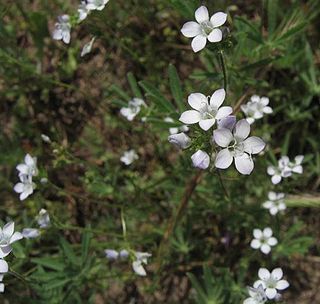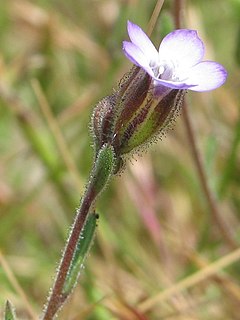
Gilia angelensis is a species of flowering plant in the phlox family known by the common name chaparral gilia. It is native to the coastal hills and mountains of California and Baja California, where it is a member of the chaparral ecosystem., especially in the Transverse Ranges.

Gilia millefoliata is a species of flowering plant in the phlox family known by the common name manyleaf gilia. It is native to the coastline of Oregon and northern California, where it grows in sand dune habitat.
Gilia minor is a species of flowering plant in the phlox family known by the common name little gilia. It is native to the Mojave Desert and it is also present in the coastal Santa Lucia Mountains of central-southern coastal California.

Saltugilia splendens is a species of flowering plant in the phlox family known by the common names splendid woodland-gilia, Grinnell's gilia and splendid gilia.
Gilia diegensis is a species of flowering plant in the phlox family known by the common name coastal gilia.

Aliciella is a genus of plants in the phlox family. These plants have been treated as members of genus Gilia until recently, when it was proposed they be moved back to Aliciella. This genus was created in 1905 to include certain gilias that seemed distinct from most of the others, but it was abandoned soon after. Recent genetic analyses suggest it should be revived.

Aliciella leptomeria is a species of flowering plant in the phlox family known by the common names sand gilia and Great Basin gilia. It is native to the Western United States, where it grows in many types of habitat, such as the sagebrush of the Great Basin and in the Mojave Desert.

Linanthus maculatus is a species of flowering plant in the phlox family known by the common names San Bernardino Mountain gilia and Little San Bernardino Mountains gilia. It is endemic to California, where it is known only from a few locales in the Little San Bernardino Mountains and the adjacent Palm Springs area in the northern end of the Coachella Valley. The largest populations, which may contain thousands of individuals, are located within the bounds of Joshua Tree National Park. This is a very small annual herb no more than three centimeters high. It has a taproot which may exceed 6 centimeters in length to collect moisture from the dry desert sand in its native habitat. The tiny, hairy stem branches to form small matted clusters on the sand surface. The hairy leaves are just a few millimeters long and unlobed. The inflorescence is a dense cluster of flowers each only 2 to 5 millimeters wide. The flower corolla has curled-back lobes which are white, sometimes with a spot of purple or pink. The protruding stamens are yellow. The main threat to this species is development in its range, and it is also vulnerable to off-road vehicle damage in the wide open sandy flats where it grows.

Aliciella micromeria is a species of flowering plant in the phlox family known by the common name dainty gilia. It is native to the western United States, especially the Great Basin. It is a small herb producing a thin, branching stem up to about 14 centimeters tall. It is coated thinly in soft hairs. Several deeply lobed leaves 1 to 6 centimeters long are located in a basal rosette at ground level around the stem. There are smaller, unlobed leaves along the stem. The inflorescence produces white or lavender flowers each about 3 millimeters wide.
Aliciella subacaulis is a species of flowering plant in the phlox family known by the common name pinyon gilia. It is native to the western United States from California to Wyoming, where it grows in several types of habitat, such as sagebrush and desert woodlands. This herb produces a glandular stem up to about 30 centimeters tall, surrounded at the base by an erect cluster of lobed leaves each up to 7 centimeters long. There are also smaller, unlobed leaves along the stem. The inflorescence is a loose cluster of purple-washed white flowers with yellow-spotted throats.
Gilia transmontana is a species of flowering plant in the phlox family known by the common name transmontane gilia. It is native to the western United States from California to Utah, where it grows in desert and plateau habitat.
Aliciella triodon is a species of flowering plant in the phlox family known by the common name coyote gilia. It is native to the American desert southwest from California to New Mexico, where it grows in desert habitat such as scrub and woodland. This small herb produces a thin, glandular stem not more than about 13 centimeters tall. The stem is surrounded by a basal rosette of fleshy, sharp-lobed leaves each up to 2 centimeters long. There are sometimes smaller, unlobed leaves on the stem itself. The inflorescence is a solitary flower or loose array of two or three flowers each about 5 to 7 millimeters wide. Each flower has a hair-thin tubular throat opening into a whitish corolla. The corolla lobes each have three distinct teeth.
Gilia yorkii is a rare species of flowering plant in the phlox family known by the common names Boyden Cave gilia and monarch gilia. It is endemic to Fresno County, California, where it is known from only one location in the southern Sierra Nevada. This plant grows in rock cracks in the limestone cliffs and outcrops in the chaparral and woodlands of the canyon.

Aliciella tenuis is a rare species of flowering plant in the phlox family known by the common name Mussentuchit gilia, or Mussentuchit Creek gilia. It is endemic to Utah in the United States, where it occurs only in the San Rafael Swell.
Mentzelia springeri is a species of flowering plant in the family Loasaceae known by the common name Santa Fe blazingstar. It is endemic to New Mexico in the United States, where it occurs in the Jemez Mountains.
Aliciella sedifolia is a rare species of flowering plant in the phlox family known by the common name stonecrop gilia. It is endemic to Colorado in the United States, where it is limited to a small area in the San Juan Mountains.

Aliciella caespitosa is a species of flowering plant in the phlox family known by the common names Rabbit Valley gilia and Wonderland Alice-flower. It is endemic to Utah, where it is known only from Wayne County.
Aliciella penstemonoides is a species of flowering plant in the phlox family known by the common names Black Canyon gilia and beardtongue gilia. It is endemic to Colorado in the United States.

Aliciella latifolia, also known as broad-leaved gilia, is a foul smelling annual plant in the Phlox family (Polemoniaceae) found in deserts of the southwestern United States.
Aliciella subnuda is a biennial or perennial plant in the phlox family (Polemoniaceae) found in the Colorado Plateau and Canyonlands region of the southwestern United States.









